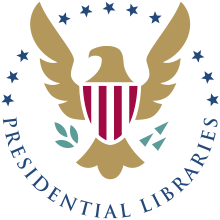
Back Präsidentenbibliothek German Bibliotecas presidenciales de Estados Unidos Spanish کتابخانه ریاستجمهوری آمریکا Persian Presidentin kirjasto Finnish Bibliothèque présidentielle French הספריות הנשיאותיות בארצות הברית HE Biblioteca presidenziale Italian 大統領図書館 Japanese 대통령 도서관 Korean Presidentiële bibliotheek Dutch

In the United States, the presidential library system is a nationwide network of 16 libraries administered by the Office of Presidential Libraries, which is part of the National Archives and Records Administration (NARA). These are repositories for preserving and making available the papers, records, collections and other historical materials of every president of the United States since Herbert Hoover, the 31st president from 1929–1933. In addition to the library services, museum exhibitions concerning the presidency are displayed.
Although recognized as having historical significance, before the mid-20th century presidential papers and effects were generally understood to be the private property of the president. Franklin D. Roosevelt (32nd president, 1933–1945) proposed to leave his papers to the public in a building donated by him on his Hyde Park, New York, estate. Since then, a series of laws established the public keeping of documents and the presidential library system. While not sanctioned and maintained by NARA, libraries have also been organized for several presidents who preceded Hoover and the official start of the Presidential Library Office.
The library sites are sometimes referred to as presidential centers. The Barack Obama Presidential Center (44th president, 2009–2017) is the most recent library, and operates under a new model. The Barack Obama Presidential Library is fully digitized, preserved, and administered by NARA with archival materials lent to the privately operated Presidential Center for display.[1]
- ^ "Information About New Model for Obama Presidential Library". National Archives. February 25, 2019. Retrieved July 25, 2021.
© MMXXIII Rich X Search. We shall prevail. All rights reserved. Rich X Search